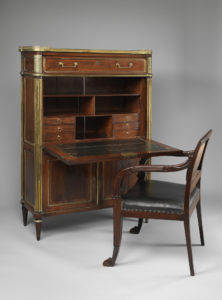More than 70 artifacts from the James Monroe Museum now can be viewed online, thanks to a new partnership between the Google Cultural Institute and the Fredericksburg museum.

This new virtual collection displays historically significant artifacts illustrating the life and times of James Monroe in just a few clicks at https://www.google.com/culturalinstitute/beta/partner/the-james-monroe-museum. The display is part of Google Arts & Culture’s Presidents Day collection celebrating the history of the U.S. presidency from George Washington to the present day.
“Being part of the Presidents Day Collection helps our museum bring the distinguished legacy of James Monroe to a worldwide audience,” said Museum Director Scott Harris. “We are grateful to Google Arts & Culture for the opportunity, and for their generous technical and marketing support.”
James Monroe compiled a long and varied public service career that included combat in the Revolutionary War; state and federal legislative offices; four terms as governor of Virginia; diplomatic postings to Great Britain, Spain and France (where he helped negotiate the Louisiana Purchase Treaty); and simultaneous service as secretary of state and secretary of war. As the nation’s fifth president, Monroe signed the Missouri Compromise of 1820, a major milestone in the sectional controversy over slavery; gave diplomatic recognition to emerging Latin American republics; acquired Florida from Spain; and in 1823 committed the U.S. to preventing European intervention in the affairs of the Western Hemisphere. This declaration, later termed the Monroe Doctrine, was a cornerstone of American foreign policy well into the 20th century.

The virtual exhibit has been developed for online visitors to discover interactive stories curated by James Monroe Museum experts. The exhibition tells the story of the man who held more public service jobs before assuming the presidency than any other holder of the office.
Included in the online exhibition are:
- Valley Forge Furlough: Issued by Maj. James Monroe to Lt. John Wallace of the Sixth Pennsylvania Infantry Regiment in February 1778 while the Continental Army was encamped at Valley Forge, this furlough bears the earliest known signature of Monroe on an official document.
- Court Suit: Monroe’s elegant diplomatic attire represents this important aspect of his career in public affairs, including his presence, with his wife, Elizabeth, at the coronation of Napoleon Bonaparte as emperor of the French on Dec. 2, 1804.
- Painting of Monroe’s Return to Washington, 1817: This oil painting by Pietro Bonanni depicts Monroe returning to Washington, D.C., from the first of three regional tours between 1817 and 1819. By bringing the presidency directly to the people, Monroe made the office more accessible and tangible for a large segment of the population.
- Official White House China: The large dessert service ordered by Monroe from the Paris firm of Pierre Louis Dagoty and Edouard D. Honoré is the first official china service made specifically for an American president. It symbolizes the grand style of White House furnishings that Monroe acquired to reflect the power and dignity of the President’s House.
- Monroe Doctrine Desk: Monroe family tradition holds that this mahogany Louis XVI-style desk, acquired in France in the 1790s, was used by the president to write his annual message to Congress in 1823 that included the Monroe Doctrine.
The James Monroe Museum, located at 908 Charles St., holds the country’s largest collection of artifacts and documents related to the fifth U.S. president. Given to the commonwealth of Virginia in 1964, the museum is administered by the University of Mary Washington. Google Arts & Culture is a new, immersive way to experience art, history, culture and world wonders from more than a thousand organizations worldwide.